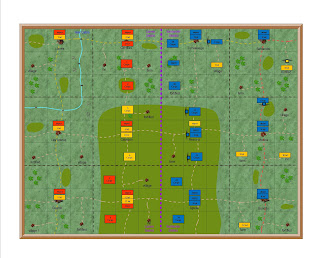22 May 1813 - Southern Germany - Day 2
Marshal Massena orders the Bavarian army to advance towards the border. His intention is to defend Walchsee, Sankt and Johann and Kitzbuhel and not to cross the border and attack the Austrian army.
General Schwarzenberg orders the Austrian army to halt on the border and resupply. However he orders 3rd army, south of the river Inn, to cross the border and attack Kitzbuhel.
Battle of Kitzbuhel
Both armies start the battle at full strength
The French have 9 infantry, 2 cavalry and 2 artillery brigades
The Austrians have 8 infantry, 2 cavalry and 2 artillery brigades
Marshal Victor takes the best infantry brigade from each corps to
support the garrison
17th and 18th corps are ordered to move forward to
support the town
General Merveldt takes the two best infantry brigades from each corps to
form the attack force
This leaves 5th and 6th corps weaker than their
opposing French corps
Their orders are to contain the enemy, but not to attack
It is his intention to take the town with his strong reserve of four
infantry brigades
The Austrians win the battle of Kitzbuhel.
French suffer 9 infantry, 1 cavalry and 1 artillery casualties (3800
men)
Austrians suffer 3 infantry and 1 cavalry casualties (1300 men)
Comment
The Austrians
open the campaign with an attack on Kitzbuhel, south of the river Inn
If they win they
hope to cause the French to retreat from their battle line along the border
Both armies are
full strength, but the French also have a conscript brigade as garrison of
Kitzbuhel
However both
French corps are still in their peace time locations, four hours west of the
town
This is so that
they can receive supplies from the three western towns
The Austrian
plan is to attack the town with the four best infantry brigades in the army
The two corps
will then be outnumbered and will attempt to pin, but not attack, the French
5th
Austrian corps (north of the town) deploy with their artillery at short range
from the town
The French cavalry
advance to attack the guns, but are driven off by the Austrian hussars
The Austrian
guns cause 30% casualties causing the French to commit their reserve brigade
The Austrian
infantry take the northern half of the town and rout both French brigades
All four
Austrian brigades then attack and take the southern half of the town
The terrain
south of the town makes it impossible for 6th corps to deploy at
close range of the town.
They exchange
fire with 18th French corps, but neither side do much damage
The French played a very defensive game, and paid the consequences. Both corps were stronger than the Austrian corps opposite. But neither took advantage and attacked. In the north this was due to the loss of their cavalry early in the game. In the south it was due to difficult terrain
The French were outnumbered in the centre, and worse still half of the Austrian artillery were allowed to deploy within close range of the garrison.
The advantage always lies with the attacker. The defender must deploy first, and the attacker can then concentrate to attack the weakest part of the defence.
Despite this the attacker must gain an advantage, particularly to attack a strong garrison. This usually puts him at a disadvantage, for example 5th Austrian corps outnumbered by 17th French corps. But the defender must counter this early in the game. This is why the French sent forward their cavalry. But having lost the melee, even though the cavalry did rally later in the game, they were unable to send forward their stronger infantry to attack 5th Austrian corps.
This was disappointing start to the campaign for the French. However the Austrians needed an early victory to push the French back from their strong defensive positions on the border.










